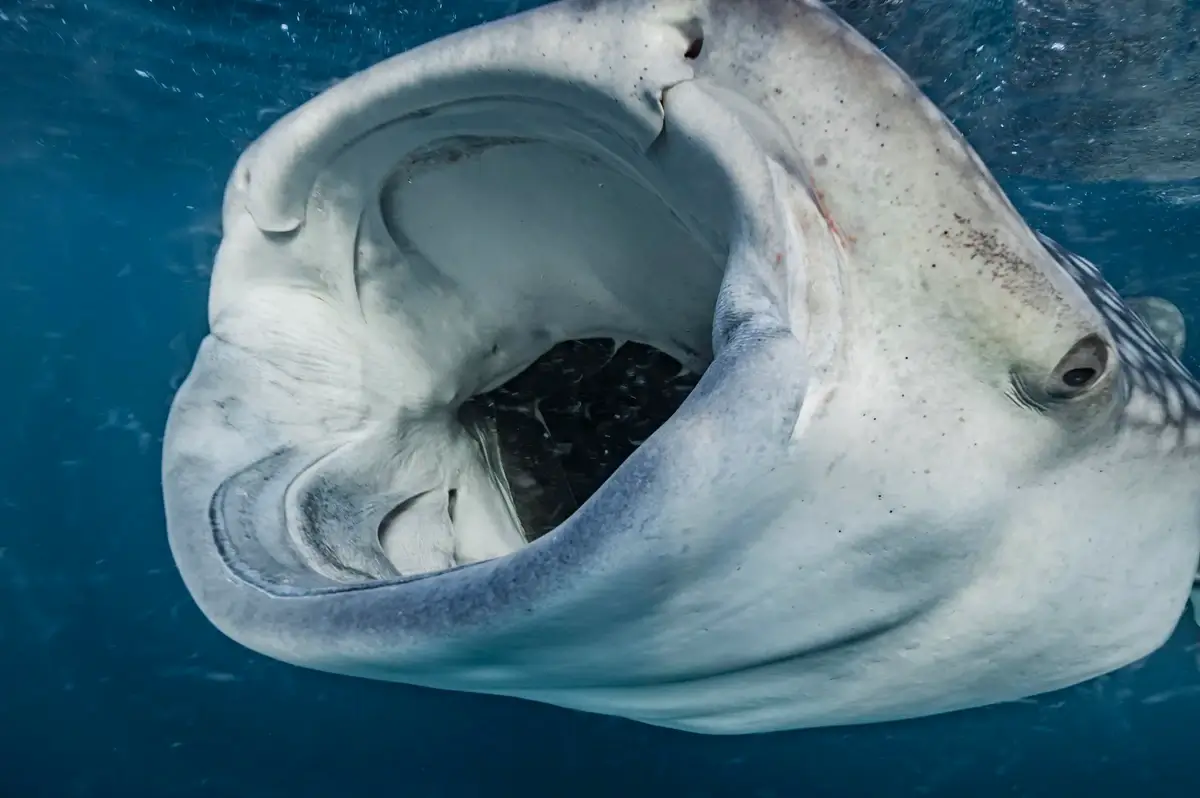Whale sharks are the ocean’s largest fish, reaching lengths of over 60 feet and weighing up to 20.6 tons. Despite their size, these gentle giants are filter feeders, dining on tiny plankton and krill.
Each whale shark boasts a unique pattern of spots, much like human fingerprints. They can live up to 100 years, yet their breeding habits remain a mystery. Found in warm waters worldwide, they are protected due to their vulnerable status. Intrigued? Discover more fascinating details in our compilation of fun facts about whale shark.
1. Largest Fish in the Sea
The whale shark holds the title of the largest fish in the sea, a truly magnificent creature that can grow to extraordinary sizes. On average, adult whale sharks reach lengths of about 12 meters (39 feet), but the largest accurately recorded specimen was a staggering 18 meters (59 feet) long.
These gentle giants can weigh up to 20 tons, making them not only the largest fish but also among the heaviest creatures in the ocean.
2. Gentle Giants

Image: padi.com
Despite their immense size, whale sharks are known for their gentle and docile nature. These magnificent creatures, reaching up to 40 feet in length and weighing around 11 tons, pose no threat to humans. Instead of hunting large prey, they are filter feeders, consuming plankton and small fish by swimming with their mouths open to filter food from the water. Their calm demeanor allows snorkelers and divers to swim alongside them without fear.
Whale sharks can be found in tropical oceans worldwide, often near the surface where food is plentiful. These giants can dive up to 1000 meters, but they are frequently spotted in shallow waters, making them accessible to eco-tourism activities. Despite their size, they exhibit a slow, peaceful swimming style, further emphasizing their gentle nature.
3. They are Filter Feeders

Image: lookphotos.com
Whale sharks are unique among sharks because they are filter feeders, consuming vast amounts of plankton, krill, and small fish. They can filter up to 1,500 gallons of water per hour through their gills. This incredible feeding mechanism involves their large mouths, which can open up to five feet wide, and specialized gill rakers that trap tiny organisms as water passes through.
These gentle giants use two main methods to feed: ram filtration and active suction feeding. In ram filtration, whale sharks swim with their mouths open, allowing water and food to flow in. In active suction feeding, they open and close their mouths to suck in water and prey. The water then passes over their gill rakers, which act like sieves to capture food particles while expelling the water.
This feeding strategy not only sustains their enormous size but also plays a crucial role in the marine ecosystem by helping control plankton populations. Whale sharks have been observed “coughing” to clear their filter pads of debris, ensuring their feeding apparatus remains efficient.
4. Whale Sharks – Long-Lived
Whale sharks are known for their impressive longevity, with estimates suggesting they can live up to 70 to 100 years. This makes them one of the longest-living marine species.
These gentle giants grow slowly, and their extended lifespan allows them to reach full maturity around the age of 30. This slow growth rate and long life span are essential for their survival, as it allows them ample time to reproduce and sustain their population, although they face numerous threats in the wild.
5. They Prefer Warm Waters
Whale sharks prefer the balmy temperatures of tropical and subtropical oceans, often found in regions where the water is at least 21°C (70°F). These gentle giants are known to inhabit warm waters around the globe, including popular sites such as the Philippines, Australia, Mexico, and Mozambique. Their preference for warm waters is not just about comfort; these areas are rich in plankton, krill, and other small marine creatures that make up their diet.
Interestingly, whale sharks often migrate to specific feeding grounds. For example, the Ningaloo Reef in Western Australia is a famous spot where these sharks gather annually. Such migrations are influenced by ocean currents and the availability of food, highlighting their dependence on warm, nutrient-rich waters for survival.
6. Whale Sharks are Very Slow
Whale sharks swim at a leisurely pace of around 3 miles per hour, allowing them to cover vast distances without expending much energy. This slow speed is typical for such large animals, enabling them to efficiently filter feed on plankton, krill, and small fish as they move through the water.
Despite their slow pace, whale sharks are known to travel thousands of miles between feeding grounds, making them one of the most widely distributed marine species.
7. They Have a Huge Mouth

Image: forbes.com
Whale sharks, the largest fish in the ocean, possess equally impressive mouths that can stretch up to 5 feet wide. This massive mouth is located at the front of their head, allowing them to swim forward with their mouths open, filtering large volumes of water to capture plankton, krill, and small fish. Despite having up to 300 rows of tiny teeth, these are not used for feeding but are evolutionary remnants.
8. Whale Sharks’ Vertical Feeding Technique

Image: nationalgeographic.com
Whale sharks sometimes adopt a vertical feeding position, standing on their tails to consume dense patches of plankton and small fish. This behavior allows them to effectively filter large volumes of water rich in food particles.
Using their unique suction filter-feeding technique, they draw water into their mouths at higher velocities, capturing a variety of prey, from plankton to larger nektonic organisms. This feeding method is particularly efficient in dense prey aggregations, enhancing their ability to sustain themselves in nutrient-rich areas.
9. They Give Birth to Live Pups
Female whale sharks give birth to live young, known as pups, which can number in the hundreds. This prolific reproductive strategy is a fascinating aspect of their biology.
Unlike many fish that lay eggs, whale sharks are ovoviviparous, meaning the eggs hatch inside the mother’s body, and she gives birth to live pups. In 1995, a pregnant whale shark was discovered with over 300 embryos, showcasing their incredible reproductive capacity.
10. They Have a Long Gestation Period

A pregnant whale shark. Image: DiveAdvisor
It is believed that whale sharks have one of the longest gestation periods of any animal, though exact figures are still being researched. Estimates suggest that their gestation period could last up to 14 months or longer. This extended gestation is inferred from their slow growth rates and the size of pups at birth.
However, due to the elusive nature of these gentle giants and the challenges in studying their reproduction in the wild, precise data remains difficult to obtain. Continued research is crucial to better understand the reproductive biology of these magnificent creatures.
11. Late Maturity
Whale sharks reach sexual maturity at around 30 years of age, contributing to their slow population growth. This delayed maturity is significant for conservation efforts, as it means whale sharks reproduce less frequently over their lifetimes compared to other marine species.
Their slow growth rate and extended lifespan, which can reach up to 100 years, further emphasize the need for protective measures to ensure their survival. The long time to reach reproductive age makes them particularly vulnerable to threats like overfishing and habitat destruction.
12. They are Not Related to Whales
Despite their name, whale sharks are not related to whales. They are classified as fish, not mammals. Whale sharks belong to the class Chondrichthyes, which includes all sharks, rays, and skates.
Unlike whales, which are warm-blooded mammals that give live birth and breathe air, whale sharks are cold-blooded, lay eggs, and extract oxygen from water through gills. Their name derives from their massive size, similar to whales, but biologically, they are more akin to other shark species.
13. Record-Breaking Whale Shark

Image: bloomberg.com
The longest whale shark ever recorded was an astonishing 62 feet (18.8 meters) long, found off the coast of Pakistan in 1947. This makes whale sharks not only the largest fish alive today but potentially the largest fish to have ever existed.
Typically, whale sharks reach lengths of about 39 feet (12 meters), but this exceptional individual far exceeded that average.
14. Whale Sharks: Solitary Giants
While they can sometimes be seen in groups, whale sharks are generally solitary animals. These gentle giants of the ocean are often observed alone, roaming the warm tropical and subtropical waters of the world’s oceans. However, they are known to gather in certain areas with abundant food sources, such as during seasonal plankton blooms. This aggregation behavior is particularly noted in locations like the Yucatán Peninsula, Ningaloo Reef in Australia, and the Philippines.
Whale sharks’ solitary nature contributes to the challenges in studying their behavior and migration patterns. Their tendency to travel alone and cover vast distances during migrations makes tracking and researching them a complex task for marine biologists.
15. Whale Sharks are Noisy Eaters
Whale sharks, despite their size, make a distinctive noise when feeding. This noise, often described as a sucking or slurping sound, is produced as they filter-feed on plankton and small fish. Divers have reported hearing these sounds while swimming near feeding whale sharks.
The noise is generated by the rapid intake of water and the subsequent expulsion through their gill slits, a process essential for capturing their microscopic prey.
16. They are Deep Divers

Image: oceanographicmagazine.com
Whale sharks, while commonly seen near the surface, are capable of diving to impressive depths. These gentle giants have been recorded diving to depths exceeding 4,000 feet (1,219 meters), with some dives reaching almost 6,000 feet (1,800 meters). This deep-diving behavior is still a mystery to scientists, who speculate it could be related to feeding, navigation, or other unknown reasons.
Despite their ability to dive deep, whale sharks are primarily found in warm, surface waters where they feed on plankton, fish eggs, and small fish.
17. Ancient Survivors
Fossil records indicate that whale sharks have existed for around 60 million years, enduring several mass extinctions. This longevity highlights their remarkable adaptability and resilience in changing oceanic environments.
18. Global Wanderers
Whale sharks inhabit all major tropical and warm-temperate oceans, including the Atlantic, Indian, and Pacific Oceans. These gentle giants are frequently spotted in regions like the Gulf of Mexico, the Maldives, and the Great Barrier Reef.
Their wide distribution is driven by the availability of plankton and small fish, which constitute their primary diet. Whale sharks undertake long migrations, often crossing entire ocean basins, highlighting their role in the global marine ecosystem.
FAQ
How fast can a whale shark swim?
Whale sharks typically swim at a leisurely pace of around 3 miles per hour (5 kilometers per hour). This slow speed allows them to conserve energy while traveling long distances in search of food.
Does a whale shark have 3,000 teeth?
Yes, whale sharks have around 3,000 tiny teeth, arranged in over 300 rows. Despite this impressive number, they do not use their teeth for feeding, as they are filter feeders and primarily consume plankton.
Do whale sharks sleep?
Whale sharks do not sleep in the traditional sense. Like many other fish, they must keep moving to facilitate breathing, but they may rest by slowing down their movements and reducing their activity levels.
What is a whale shark’s biggest threat?
The biggest threats to whale sharks include habitat destruction, boat strikes, and being caught in fishing gear. Additionally, illegal hunting for their fins, meat, and oil poses significant dangers to their population.
Do whale sharks drink?
Whale sharks do not drink water in the way land animals do. They obtain water through their diet and absorb it through their gills while filtering plankton and other small organisms from the water.
Can you touch a whale shark?
It is generally advised not to touch whale sharks. Touching them can remove the protective mucus layer on their skin, making them more susceptible to infections and diseases. Additionally, human interaction can cause them stress and alter their natural behavior.







